My Favorite Greenery for Installations by Season
What is the best greenery or foliage to use for floral installations?
As a wedding florist who specializes in custom and unique floral installations, this is a question I get all the time! Greenery selection is so important for a floral installation design, especially if your goal is to create romantic, natural looking designs with gorgeous movement and flow.
A fellow florist, Hart Floral who I look up to and recently had the pleasure of working with casually said the words “foliage and flowers are equals in an arrangement.” And I couldn’t agree more. Although to be honest, this is not an easy concept to master. Sourcing foliages that play a leading role in a design can be tricky because it requires a bit of extra effort and care to seek them out. Let’s be real – our industry revolves around flowers, not foliage. Most people, florists included, have been trained to see greenery as a “filler” or a less important backdrop to the real stars: the flowers. But I think the most successful arrangements are the ones that use both in harmony, each part working just as hard to create a magical synergy of shape, texture and color.
This is the reason why I have decided to devote an entire post to answering this question. While some may have expected a simple answer, the real answer is more in depth because truly, the foliages I use in my designs (whenever I can help it) are carefully and thoughtfully selected for that design in particular. There isn’t really a one-size-fits-all, that is, if you want your designs to be truly unique and special.
Throughout my 13 years of working in floristry, I have experimented with all types of greenery out there on the market, and I’ve found my favorites over the years. So today I am here to share with you my very favorite greenery types and why I love them for installations! I will share with you the best year-round foliages (those reliable ones that you can depend on when all else falls through) and I will also share with you some foliages that are seasonal, so that whatever month or season you are in, you will have some great options to refer to. Maybe one of these will be the perfect one to try out for your next install!
So, let’s dive into the leaves! (…See what I did there?)
How to Choose Your Greenery
The first thing you might wonder is how to go about making your greenery selections. This can be a challenge especially if you are unfamiliar with all of the different greenery choices that are are out there! One way to start familiarizing yourself with different greenery varieties is to use a flower library or reference guide, like the Putnam Flower Color Guide. Another way to begin familiarizing yourself with greenery varieties is to ask your wholesaler for an availability list. They can provide you a list of names of all of the flowers and foliages that are available at that time of year. You can google the ones you’re unfamiliar with in an image search, and keep a personal list of ones you’d like to try. It’s always a good idea to keep a notebook or Google Sheet of varieties to remember as you are learning and becoming familiar with different types of flowers and foliage. Eventually, you will memorize all of your favorites and the ordering process will become much easier!
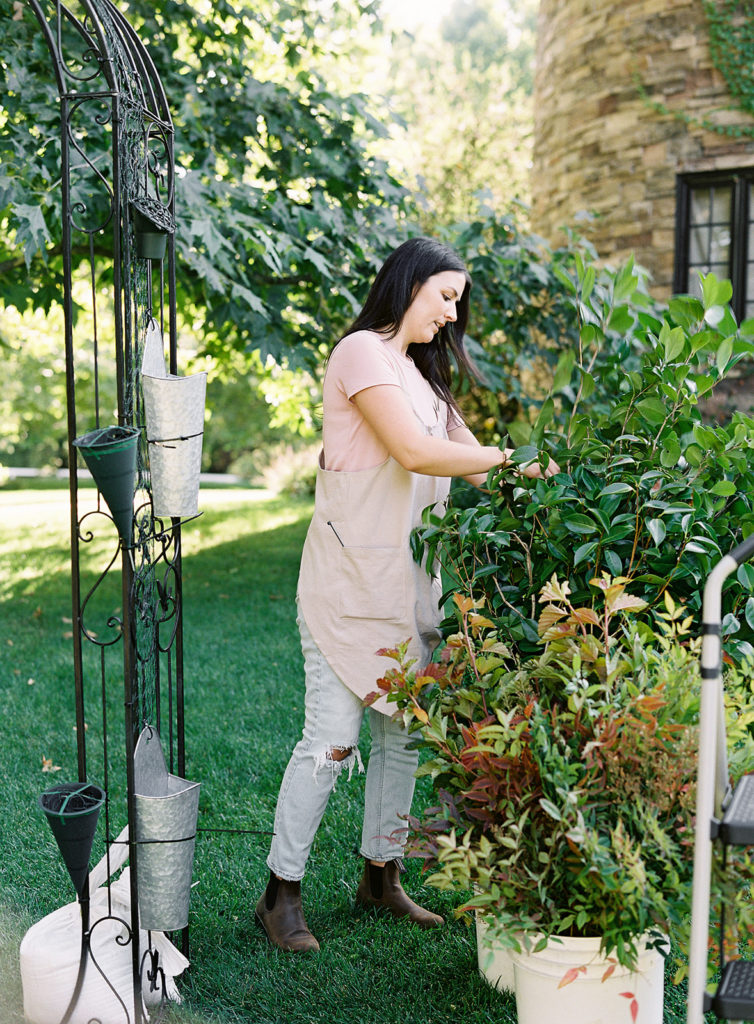
Image by Sposto Photography
How I Find Unique Greenery
The area where I live (Los Angeles County/Orange County/Inland Empire) is not great for foraging. If you are fortunate to live in a lush area with lots of beautiful vegetation (Hello PNW!) You might have greenery around your area that you can forage. If I did live in an area that was good for foraging, I would cut any branch or foliage stem that I liked the look of, and give it a test in a vase to see how it holds up. One big difference between cutting plants from the wild and buying them from a wholesaler is that wholesalers carry plants that are already tried and tested, and usually bred for having a strong vase life. So if you do decide to forage greenery for your designs, it’s important to test it out to see how well it lasts when cut. Give it a test in water, in foam, and out of water and see if it passes the test.
The way I’ve discovered most of my favorite foliages over the years is by shopping the market. Aside from foraging, the best way to find great foliage options is to shop the wholesale market. If you are fortunate to live near a flower market, take advantage of the opportunity and make some regular visits. Anytime I visit my wholesaler (even if I am just picking up a pre-order) I love to do a lap around the cooler and see what’s available. This helps me discover new varieties, or to observe and take note of what’s in season at any given time. I can take notes and remember for the future if I see something seasonal that I like. If I’m not sure if it’s seasonal or year round, I might ask my wholesaler about it and they will usually have answers like how long it’s in season for, where it’s sourced from, and how easy or difficult it would be to special order.
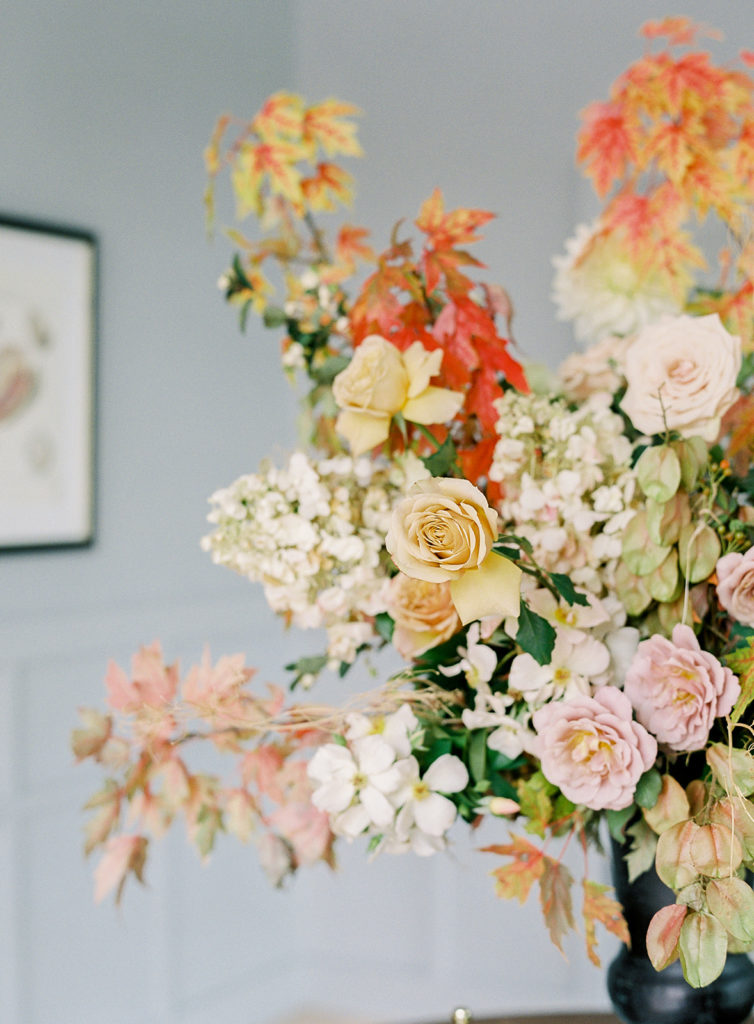
Image by Sposto Photography
Seasonal Vs. Year Round Foliages
Typically wholesalers will have their seasonal foliages and their year round foliages stored in completely different sections of the sales floor. Year-round foliages are ones that are super hardy, bred in huge quantity, usually sold in bulk by the case as well as by the bunch, and are generally always available. In the U.S., some of the most popular are foliages like Huckleberry, Salal, Camellia, Leather Leaf Fern, Ruscus, and Pittosporum. These foliages are generally carried in huge quantities and are often dry-packed in boxes and stored in the cooler. So when shopping from wholesalers, the cooler (usually somewhere towards the back) is always a good place to look for these hardy, reliable foliages.
Seasonal foliages will be available seasonally (duh) in less quantity and will depend on the region you are in and where your wholesaler has the ability to source from. These might be locally sourced, or if you are working with a larger wholesaler who can import products, they may carry seasonal items from other regions. For example, Mayesh Wholesale here in LA can bring in seasonal foliages from Washington, Oregon, the East Coast, Florida, South America, Australia, Japan, and Europe. Some of my favorite seasonal foliages are ones brought in from the Pacific Northwest – like various varieties of Vibernum. We also get beautiful Japanese Spirea in the Spring.
The best and most beautiful foliages for installations, in my opinion, are usually seasonal. Seasonal varieties usually provide the more unique shapes, long stems, and beautiful color variation that makes installations truly distinctive and unique. In the Spring time, blooming cherry blossoms can make a huge impact in an installation, Spirea can add so much shape and movement, and in the Fall, you can find Vibernum or Maple with beautiful fall colors. When foliage supports the color palette of a design, rather than being just stark green, it makes the design so much more striking and interesting. Using a golden yellow foliage in a yellow arrangement adds to the drama and intensity of the design, whereas using green foliage can dull or take away from the overall appearance. More and more, I see clients seeking more color intensity and less “greenery” in their designs. It is tricky (and expensive) to create arrangements without using foliage. But if you can find colored foliage, you can still provide coverage and a foundation for your flowers without taking away from the design. In fact, the design could be even more unique and strikingly beautiful if the foliages are selected and used thoughtfully.
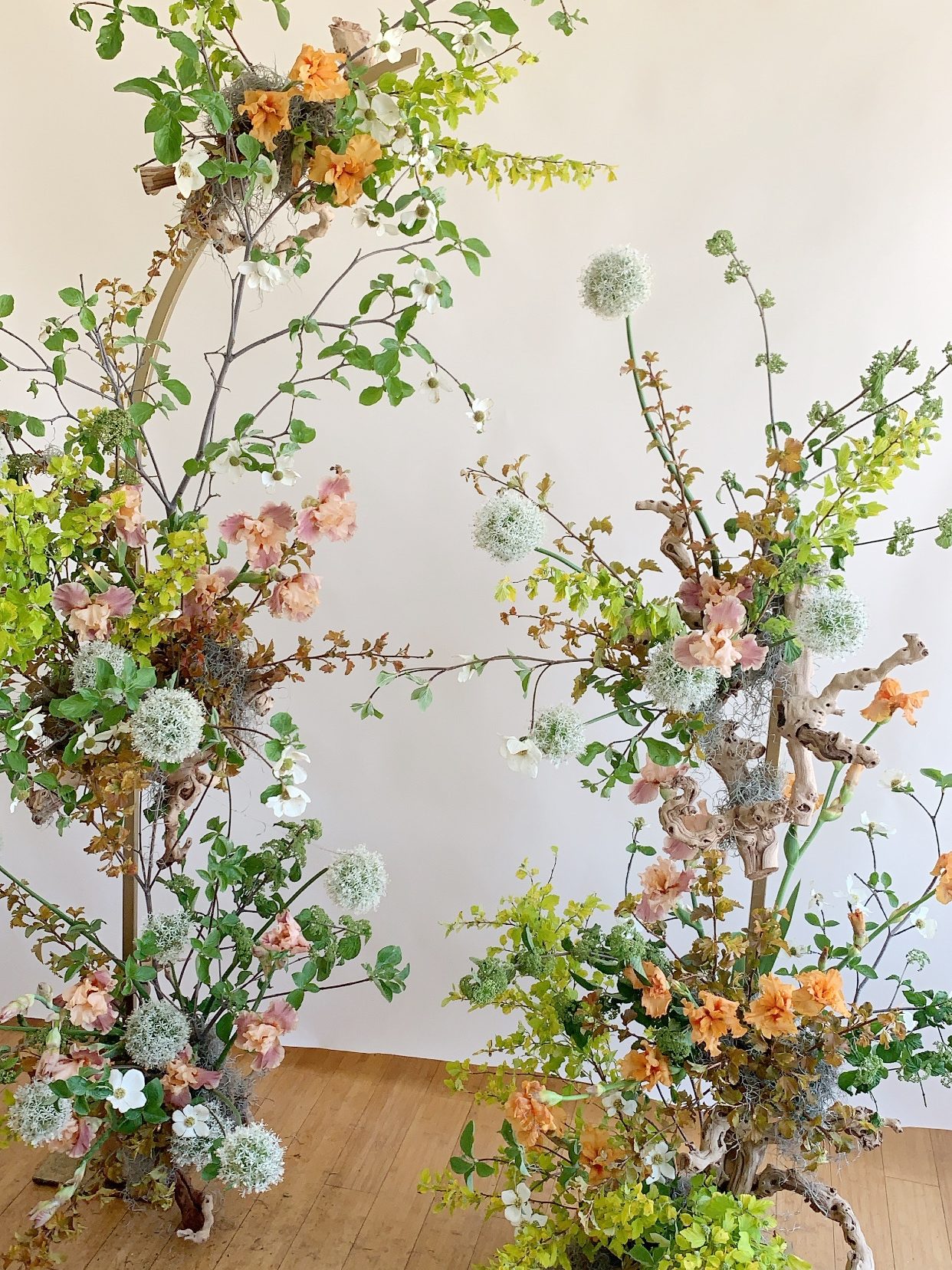
Combining 2 or More Foliages
Adding Texture, Contrast, Shape and Movement
One thing I will say is that multiple foliage varieties usually always makes for a more interesting design. If the first variety is used simply for coverage, then a second or third variety of foliage can provide contrast, movement, or additional texture. For example, when creating a classic green garden style arch, I love to use one base foliage with a broad leaf for coverage (like Salal) and then a second green foliage with a smaller leaf and more airy structure (like Huck) to add texture and break up the larger leaves. Then I will often add a third foliage with a contrasting tone (Like veriegated Pittosporum) to brighten up the darker greens and create a garden feel.
Similarly, a base foliage might provide coverage for your mechanics, while a second or third foliage might add shape and movement to your design. So for my base I might use a combination of Huckleberry and Salal, and then for shape and movement, I might use a foliage with a longer, more dynamic stem like a Spirea, Vibernum or an Autumn Maple to create some dynamic lines or shape in my design.
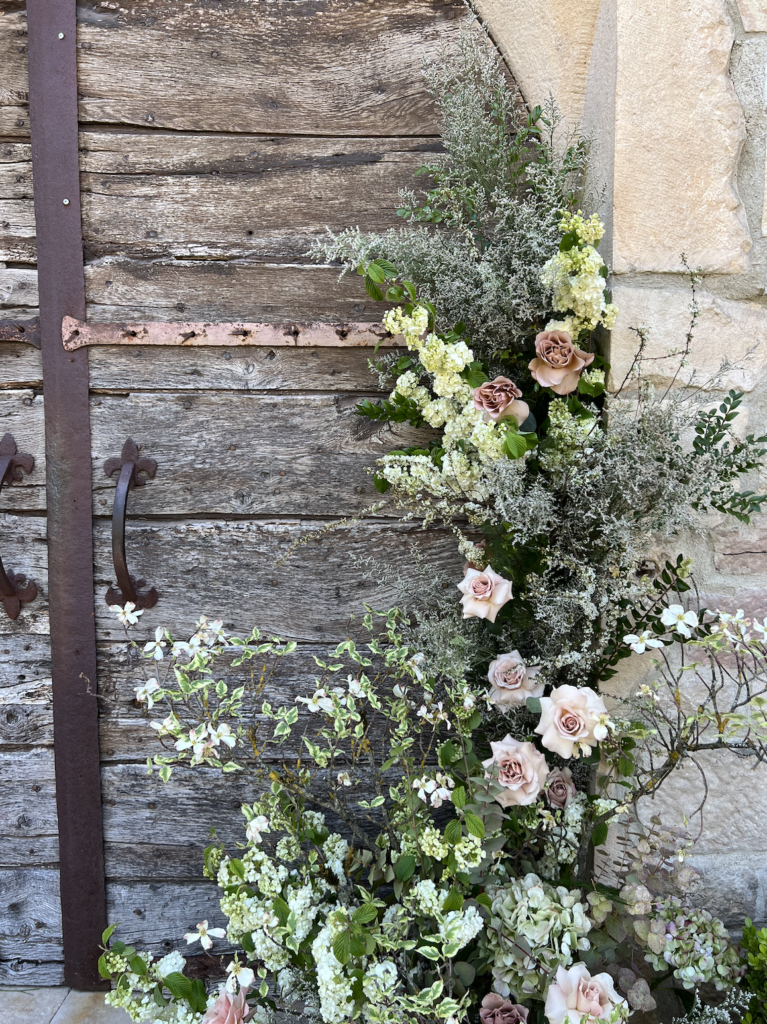
My Favorite Foliages by Season
YEAR ROUND
Year-round foliages are my secondary choice – as I will always opt for seasonal varieties when they are available – but the reliability and economical factors make them solid go-to’s when I need something I know I can count on. I will most always pre-order some combination of these reliable generic foliages for most of my weddings. That way they are there as a backup, and then I will often sub out or add on with more interesting foliages that I may find come the wedding month. These year-round foliages offer peace of mind when it comes to pretty much everything – from availability and budget to durability in heat and dry conditions. They are not the most striking or unique foliages, but they are absolutely great for creating a base and covering mechanics.
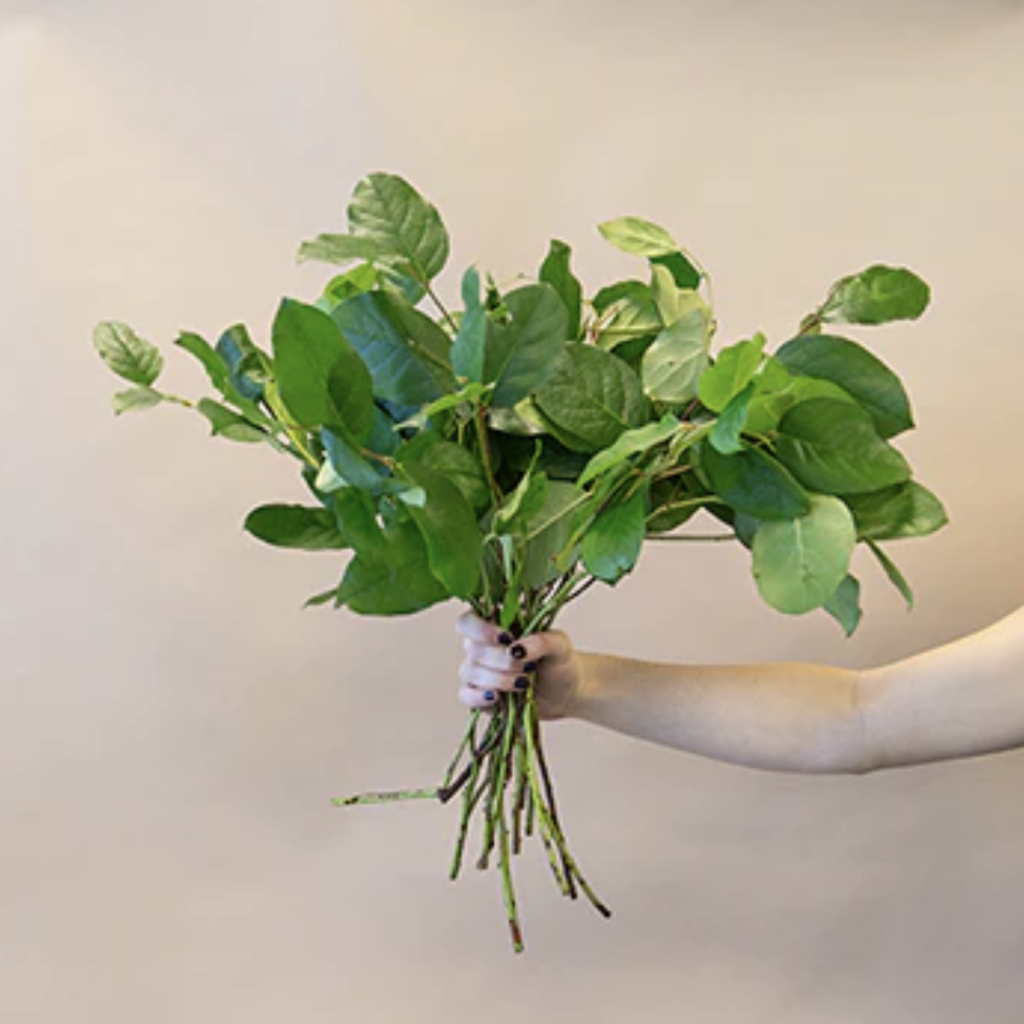
SALAL (LEMON LEAF)
Price Range: $
Water Vase Life: Excellent
Foam Life: Excellent
Out of Water: Does not do well
Qualities: Bright Green, broad leaf
Uses: Great for coverage or base
Image Source: Fifty Flowers
Salal (or Lemon Leaf) is one that even non-florists are likely familiar with. It’s probably the most generic foliage there is and is often used in grocery store bouquets. But there is a reason why Salal is so popularly used: It’s reliable! Salal has an extremely long vase life, is very hardy, and can be banged up and still not budge, break or bruise. While it may not be the most beautiful foliage, it’s broad leaves provide great coverage and it lasts well even in extreme heat. It’s also affordable at around $5.50/bunch.
We use Salal to base our foam cages in-studio for our arches and installations. Because the leaves are so durable, we can stack pre-greened cages on top of one another in long boxes, and transport them to the event so that we can zip tie them onto the structure and we save a ton of time this way by not having to do all of our greening on-site. Then will typically layer our showstoppers on top of the greened base to add shape, movement, and interest.
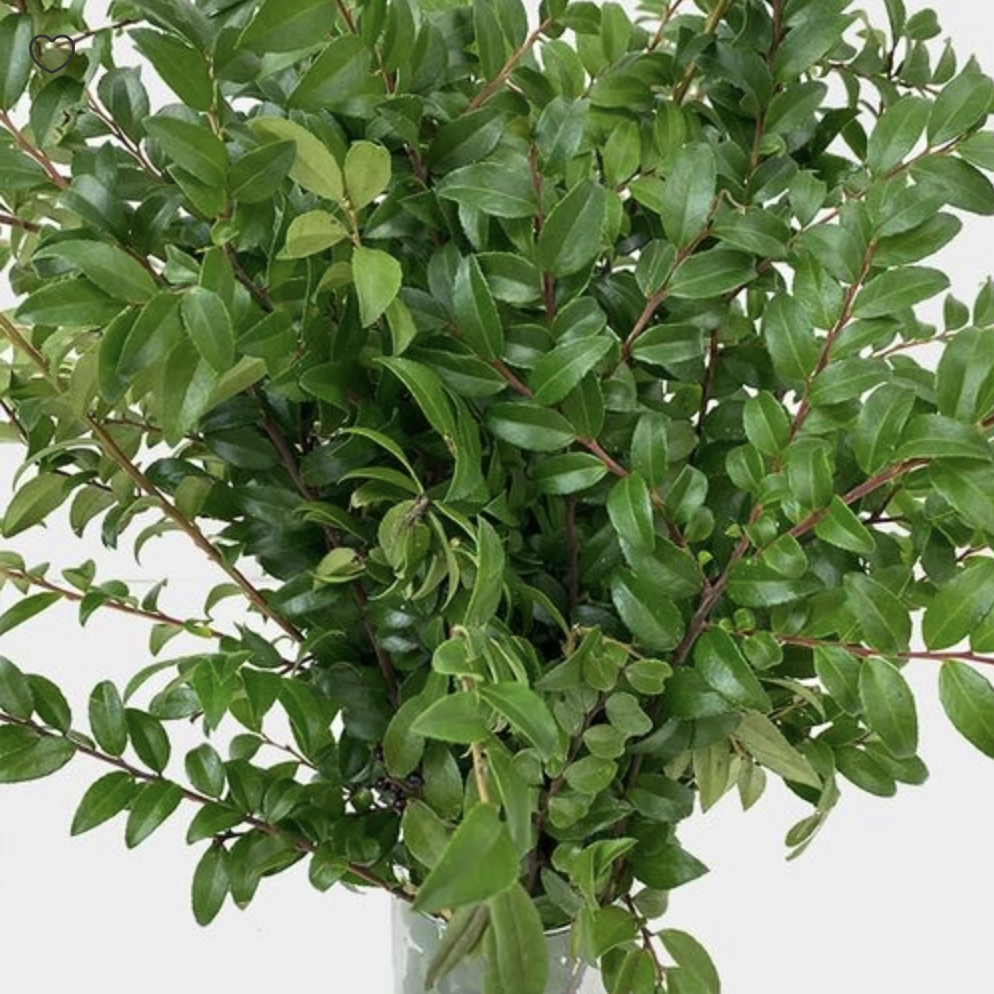
HUCKLEBERRY FOLIAGE
Price Range: $
Water Vase Life: Excellent
Foam Life: Excellent
Out of Water: 2-3 days before browning
Qualities: Bright Green, small leaf, airy structure
Uses: Great for coverage and shape
Image Source: Bloomsbythebox.com
Like Salal, Huck is reliable, hardy, durable, affordable, and great for coverage because of it’s fanned out branches dense with foliage. Huck is available by the bunch or by the 20-bunch case and runs about $5.50/bunch. So if you need to cover a large area quickly and efficiently, huck is an excellent choice.
We use huck in combination wil Salal to base our foam cages for installations. While Salal provides efficient coverage with it’s broad leaves, the Huck comes in and adds additional shape with it’s lengthier, narrower branches, as well as added texture and a little more reach.
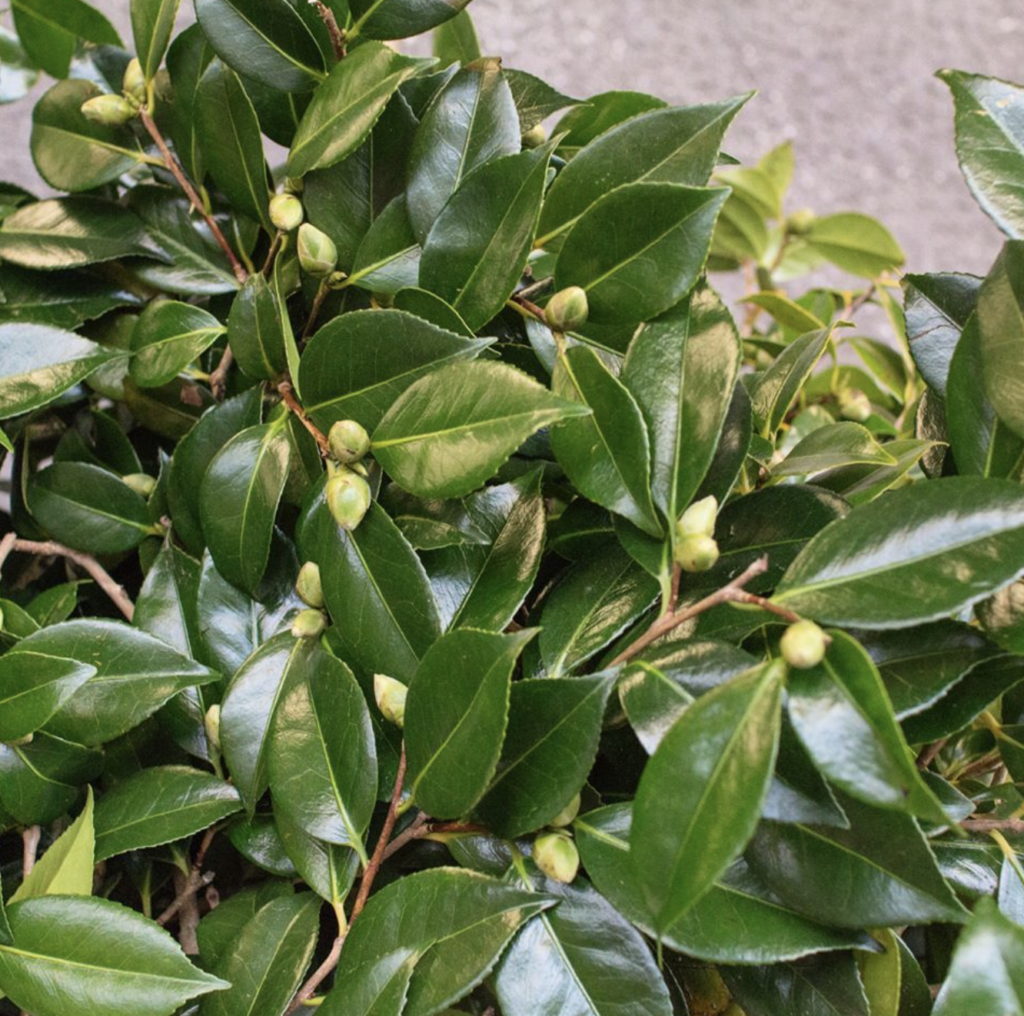
CAMELLIA FOLIAGE
Price Range: $$
Water Vase Life: Excellent
Foam Life: Excellent
Out of Water: Lasts multiple days
Qualities: Dark Green, Shiny Foliage, structured branches
Uses: Great for coverage and structure
Camellia is the same Camellia that you might be familiar with as a flowering shrub (hence the cute little buds and sometimes even flowers you will find on its branches!) But in the floral industry it’s sold mostly as a cut foliage, because of its hardy branches and beautiful lustrous leaves. Camellia has a similar structure to Salal, but with a woodier stem and a bit of a shinier leaf – which is why I love this foliage as a base option for a more refined, high-end garden look. I always layer in with a more airy, delicate foliage like Italian Pittosporum or jasmine to soften it up – it works great in a combo with any other garden foliage. Camellia is a bit pricier than Salal and huck running about $8.50/bunch, is sold by the bunch or case, and is also sold in extra tall bales that are up to 5 feet tall, which can be great for arches, urns, or anything where you need some added height.
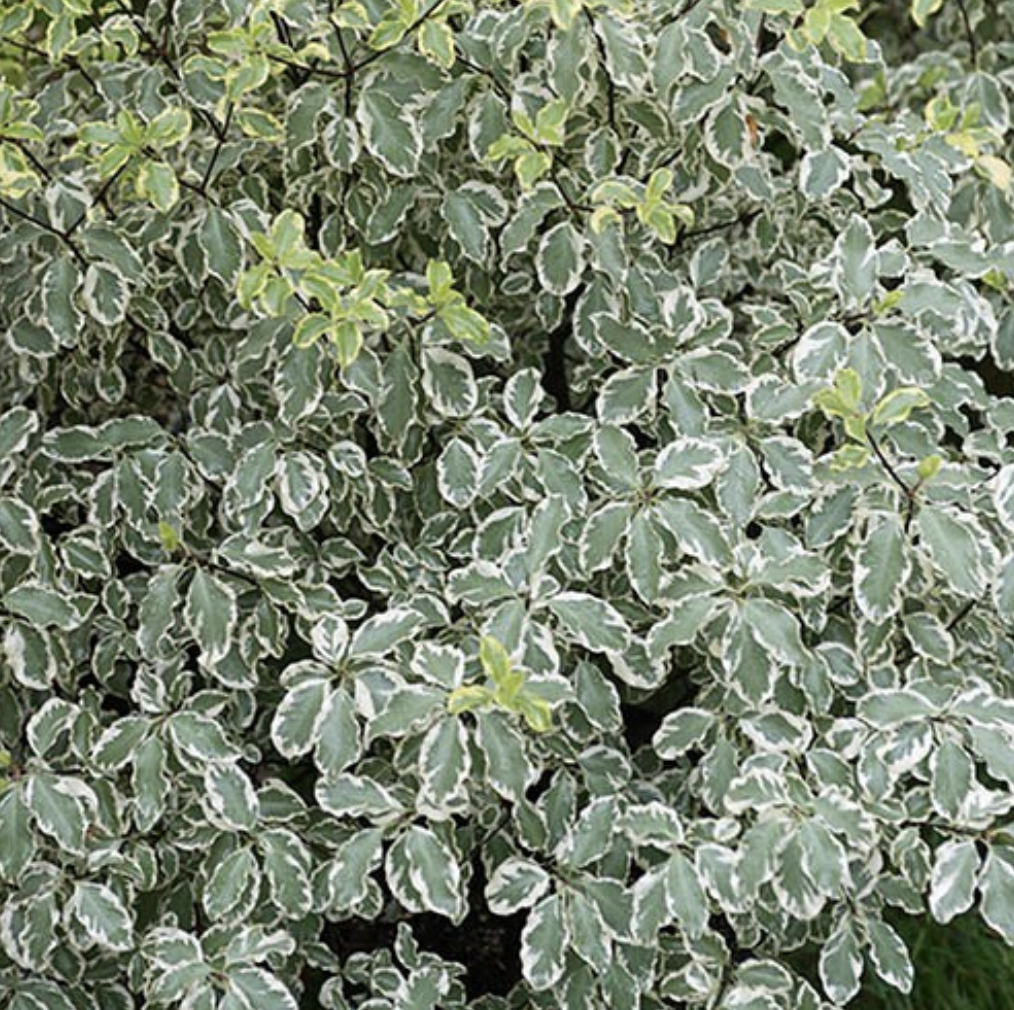
ITALIAN VARIEGATED PITTOSPORUM
Price Range: $$
Water Vase Life: Good
Foam Life: Good
Out of Water: Not recommended
Qualities: Delicate structure, variegated leaves
Uses: Great for contrast and texture
Italian Pittosporum is a more delicate foliage that has small variegated leaves which make for a lovely textured garden look. While I would not use this as a base greenery because of it’s more delicate stems and airy structure, it is 100% my go-to for softening and brightening a dark greenery base. I often will use this foliage clustered throughout an arch to break up the darker greens and give the piece a more delicate garden feel. I not only use it in installations, but in everything from centerpieces and bouquets, to bud vases, to boutonnieres and flower crowns. Sometimes you will notice some lime green tips which are new growth and can be tender when it comes to heat and lack of water, so make sure these stems stay well-hydrated when using them in your installations.
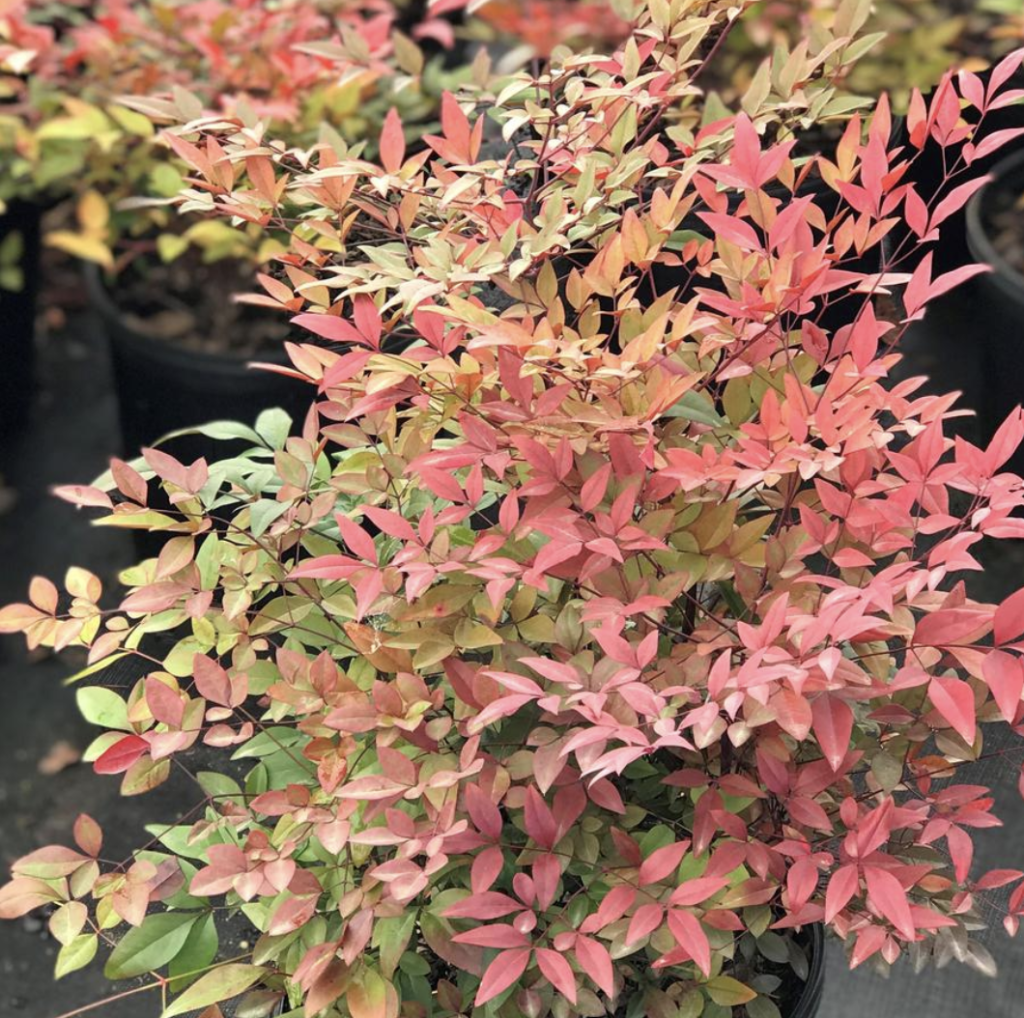
NANDINA
Price Range: $$
Water Vase Life: Good
Foam Life: Good
Out of Water: Ok for 1 day
Qualities: Large fanned out branches, beautiful leaf shape/structure, red/orange color
Uses: Coverage & introducing warm color
Ooof, this foliage is one of my favorites. A typical bunch gives you 5 large stems with fanned out, umbrella-like branches. The foliage starts out green and gets all sorts of warm orangey red tones towards the edges. When I’m scouting for a good bunch of Nandina, the more yummy warm color, the better! A healthy looking bunch will have plenty of lateral shoots filled with flat, pointed leaves. (Keep an eye out for shriveled, crunchy looking or shedding leaves which could be a sign that it’s an older bunch that has been in the cooler a bit too long.)
When healthy, even just 10 or 15 stems of Nandina can deliver some dramatic impact and really transform an arch or installation – especially if you want to introduce a warm, earthy feel. Though the colors speak Autumn, they can be beautiful in Winter arrangements, Summer or even in Spring when used thoughtfully. While typically you have to wait until September/October for all those yummy fall tones, these babies are available *almost* year round. I think that’s why I love them so much!
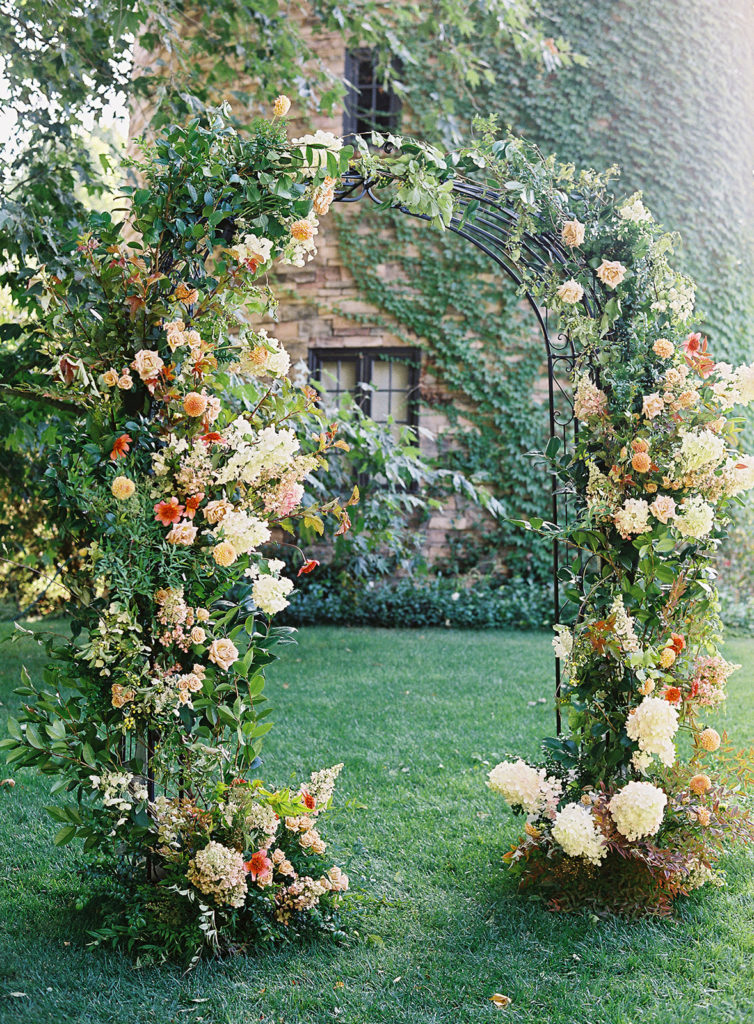
Image by Sposto Photography
SEASONAL
Seasonal foliages are the bread and butter of unique and distinctive installations. They can provide coverage, shape, texture, and color. Their dynamic qualities make them the most primary ingredient for creating striking installations that truly stand out. Any time I visit the wholesaler and have an installation to create, I always browse the seasonal foliage section of the cooler to search for any potential star ingredients. When I am traveling, I always keep an eye out for trees and shrubs that look strong, healthy and beautiful that I might be able to forage from and add to an installation. Sometimes that last-minute, unexpected find can transform your entire design!
Here are a few of my favorite seasonal foliages for installations that I use repeatedly and look forward to seeing year after year!
Working with Seasonal Foliages (The Fine Print)
Here’s the thing about working with seasonal foliages. They are SEASONAL… that means, you may get it, you may not. Even when ‘in season’ these special varieties are in limited supply and can be hit or miss. So my rules when it comes to seasonal varieties are :
1. NEVER promise it – In fact, I rarely include these in my proposal for the bride to see and get her hopes up. It’s more like an extra added surprise on the wedding day. This type of artistic liberty requires some trust from your client, but for those amazing trusting clients, well, they’re the ones that deserve the good stuff! 😉
2. Overcommunicate with your whoelsaler. Some seasonal varieties vary in appearance, stem length, color variation, etc. So if you are hoping for that perfect blushy mauve snowball vibernum, not the lime green one, make sure you send images, descriptions, etc. and specify the look you’re going for!
3. Be flexible. I tend to think of seasonal ingredients like an added bonus. If you keep your expectations low, you can never be disappointed – you’ve heard that phrase, right? That’s kinda the deal with seasonal product. This is why I always order backup foliage. If the special goodies come in, you can always swap them out with those few backup bunches of boring Salal!
In other words, if you get your hands on any of these seasonal varieties for one of your weddings, consider yourself lucky, and do a happy dance!
ANYHOO. With that, here are my seasonal favs!
SPRING
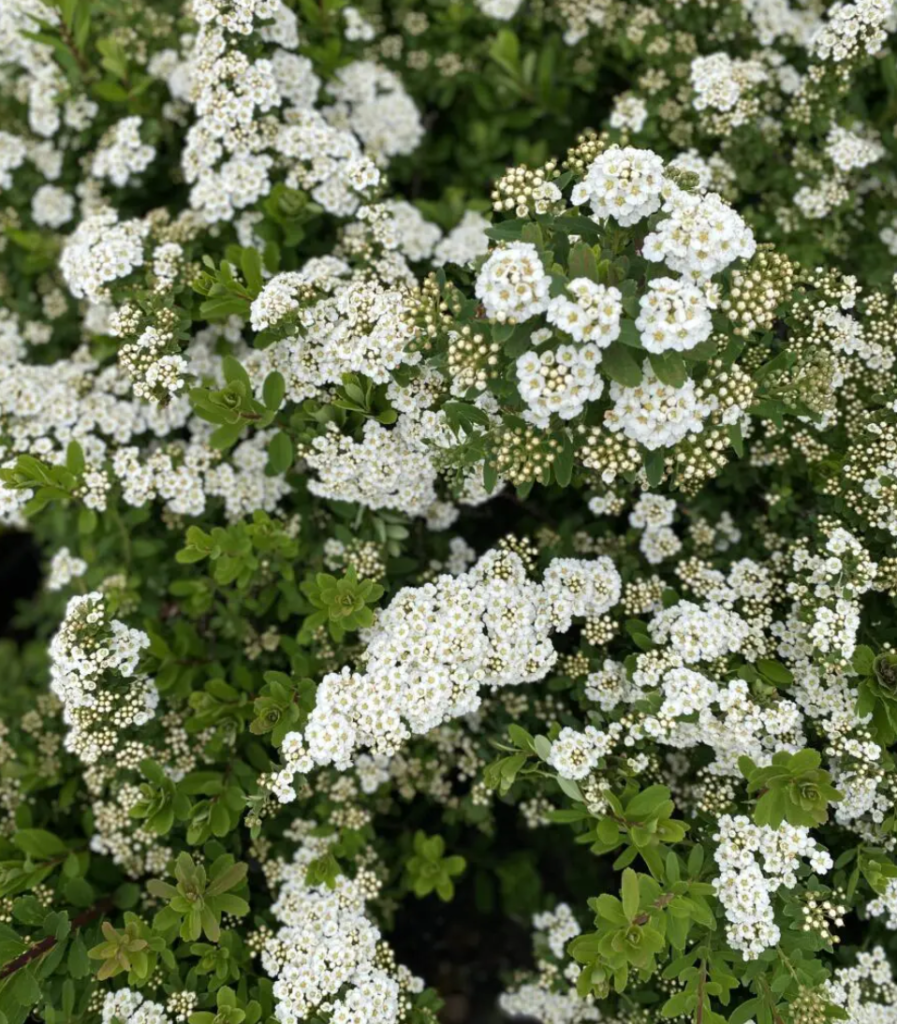
SPIREA
Price Range: $$$$
Water Vase Life: Good
Foam Life: Good
Out of Water: Not recommended
Qualities: Dainty structure, long sprawling stems, delicate white blossoms
Uses: Showstopper
Beginning in early Spring in the U.S. we start to see the first signs of Spirea from Japan. Spirea has been climbing the charts in wedding design as one of the most loved foliages by florists for the past few years. This beautiful green shrub with the most precious white blooms is utterly unmatched when it comes to premium ingredients that serve as both a foliage and flower. Because the Japanese version of this foliage is so distinctive and dainty with it’s delicately sprawling branches, florists will pay up to $6-7 per stem (wholesale!) for their weddings and events. Other local varieties usually make their appearance in early June and are not quite as spectacular but still beautiful – and bit more affordable.
Since Spirea is such a premium ingredient, I love using Spirea for impact in the important focal pieces like in an arch or urn piece for some extra drama and movement.
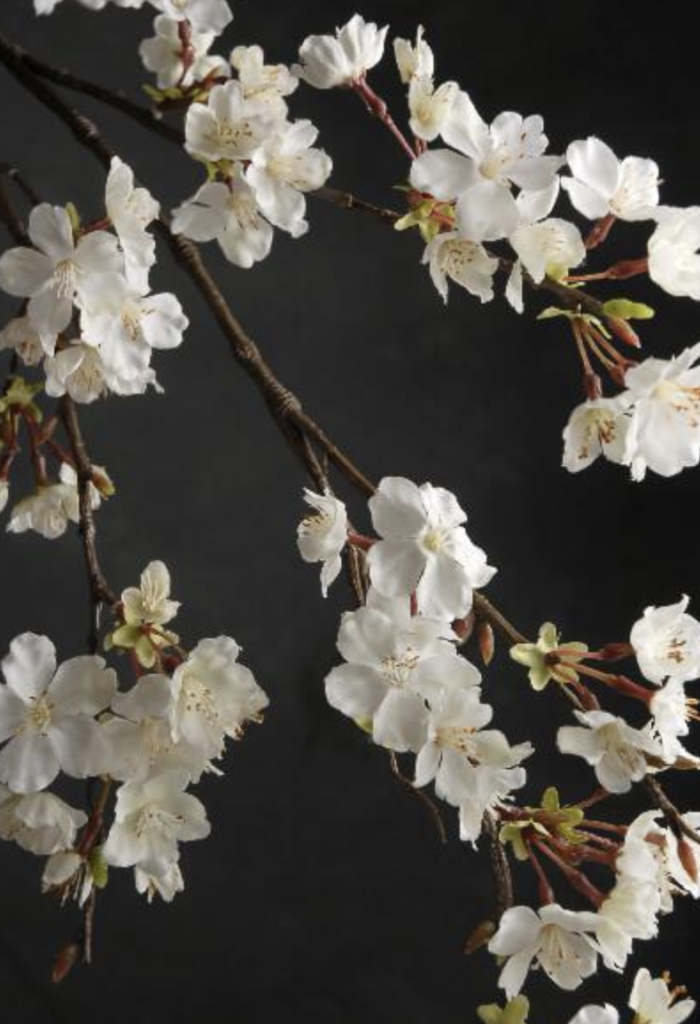
FLOWERING BRANCHES
Price Range: $$$
Water Vase Life: Good
Foam Life: Good
Out of Water: Not recommended
Qualities: Delicate & colorful blooms
Uses: Structure, Height + Drama
Okay, so it may be incorrect to lump this in as a “foliage ” but I couldn’t not include flowering branches when talking about seasonal ingredients that are great for installations! Though it might be a bit of a different look, you can get some good coverage and awesome movement with branches in a floral arch, pergola, or large scale installation. Part of embracing seasonality is thinking outside the box, and taking advantage of what is available. It’s a high risk/high reward type of situation!
Some of my favorite Spring flowering branches are Cherry Blossom, Forsythia, Dogwood, Tulip Magnolia, Almond, and Quince!
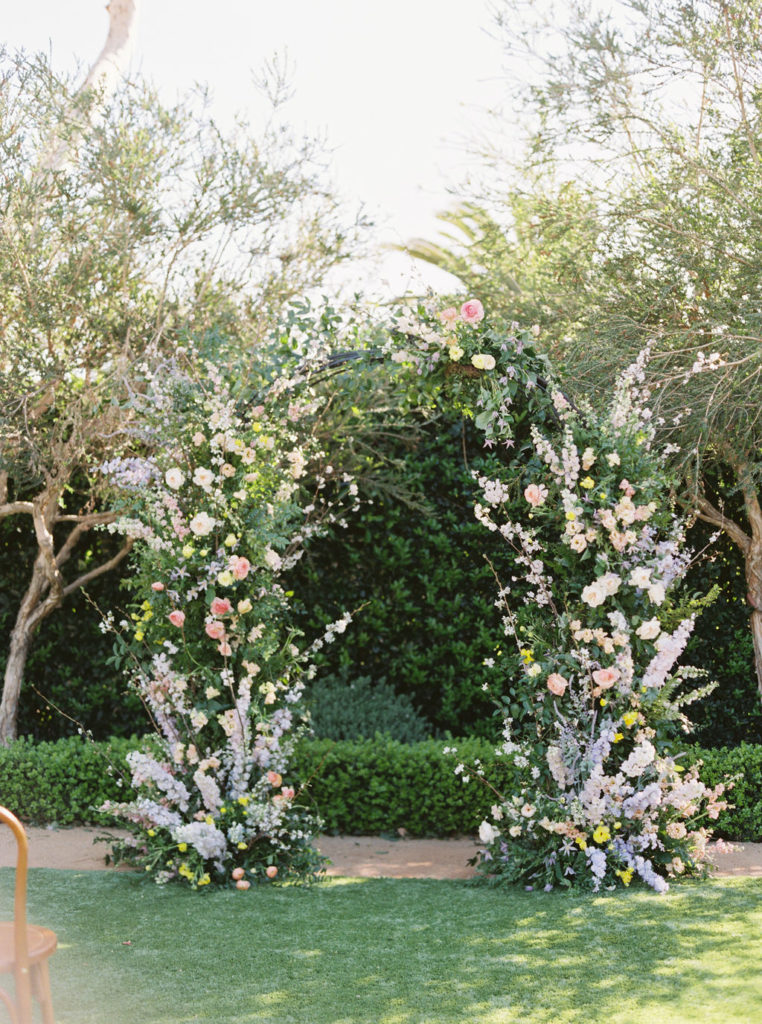
SUMMER
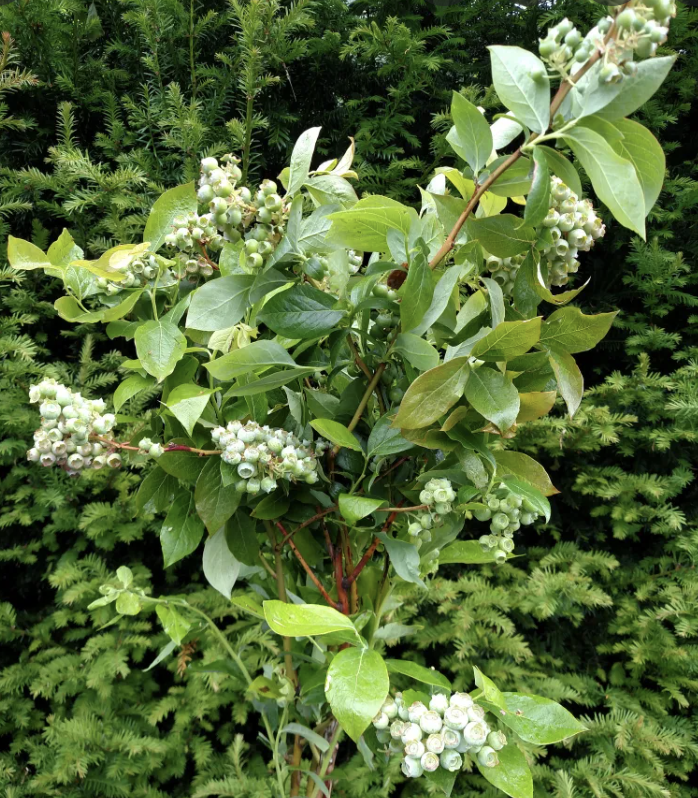
BLUEBERRY FOLIAGE
Price Range: $$$
Water Vase Life: Excellent
Foam Life: Excellent
Out of Water: A few hours before leaves wilt (Or all day in cooler weather)
Qualities: Full branches, green berry clusters, warm color tones on foliage (depending on season)
Uses: Coverage & texture
My obsession with this foliage probably comes partially from my childhood and being raised in the PNW where we grew blueberries in our yard and would go blueberry picking! Here in California these blueberries aren’t exactly native, so we get them shipped in from Oregon. Mayesh wholesale carries these beauties starting in June and I usually see them into early Fall, when the berries are less frequent and the leaves turn more of a purple-red! The leaves are strong and hardy (though they are prone to breakage if you aren’t gentle with them). But the most charming part of this foliage is OBVS the adorable berries that aren’t quite ripe … although I could figuratively EAT THEM UP! 🙂
Running $12.50 per bunch (I believe they are 5 stemmers) the stems can go a long way when used to their full length and provide all sorts of fun shapes. They also provide good coverage when tucked a bit tighter. They’re lovely in ground pieces too! I do like to make sure a few of the arched stems with their little berry clusters are popping out into the negative space where they can really be seen and appreciated- because OMG are they cute!
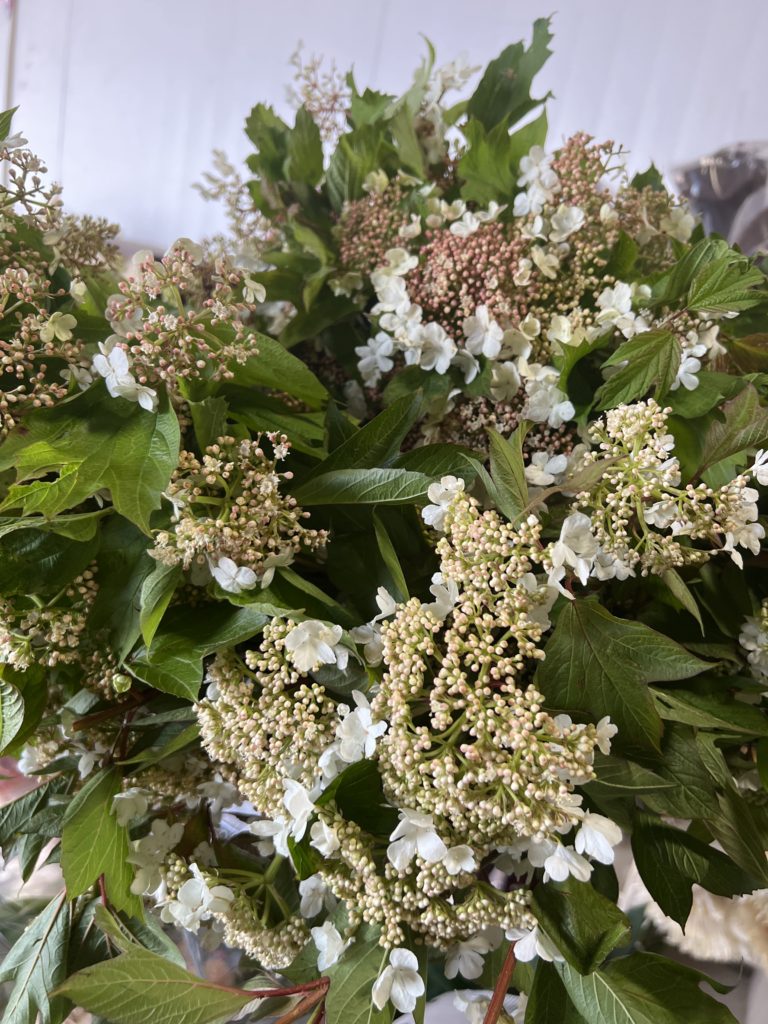
VIBERNUM LACECAP
Price Range: $$$
Water Vase Life: Good
Foam Life: Not Great (Ok if kept cool and watered)
Out of Water: Not recommended
Qualities: Pretty foliage, delicate lacey white flowers
Uses: Coverage & texture
There are A MILLION varieties of Vibernum, and I have never been good with remembering the names of all of them but this year I finally got the names of a few of my favorites. This is probably one of my top favorites, Lacecap. Its little umbrella-shaped bloom clusters at the tip of each stem are so dainty and lovely. Sometimes if you’re lucky, you’ll even get some yummy red tones in the foliage. It’s one of those wonderful stems that provides so much interest – blooms, coverage and texture all in one. Vibernum to me is the perfect foliage choice if you’re going for a garden feel.
This is one of those cold climate plants that is imported from Oregon, so the irony is that it’s seasonal in Summer but definitely does not love the heat. So if you’re going to be using this for an outdoor ceremony install, just be aware of the risk and be ready to keep it well hydrated! For the best chance, give it a long angled cut at the base of the stem (preferably with a floral knife) and if using foam, make sure it’s inserted deeply. We mist ours down with a sprayer frequently after completion until ceremony time. Because it’s a little iffy, if I’m going to use a thirsty Vibernum in an outdoor installation, I always base the design with a hardier, more reliable foliage like Huckleberry, so that way in the sad case that it doesn’t hold up, your arch won’t lose its structure or shape. For those REALLY hot days, I probably wouldn’t risk it… But for those mildly hot days, I probably would! 😉
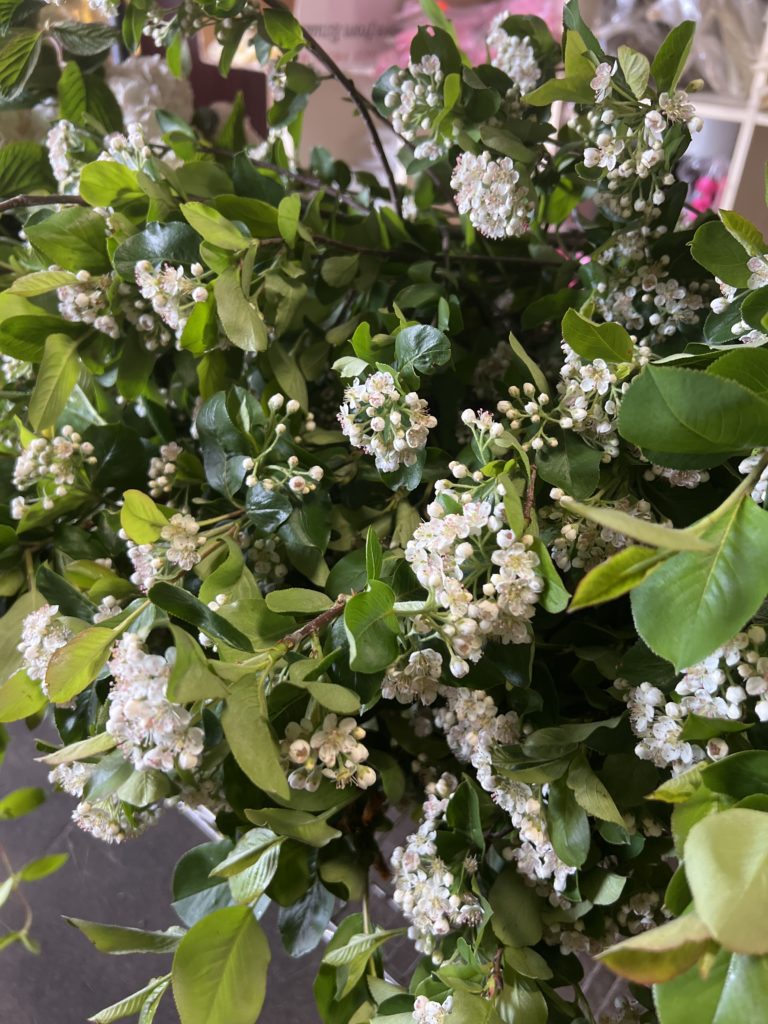
VIBERNUM ARONIA
Price Range: $$$
Water Vase Life: Good
Foam Life: Not Great (Ok if kept cool and watered)
Out of Water: Not recommended
Qualities: Pretty foliage, dense branches, delicate white flowers
Uses: Coverage & texture
My first sighting of this Vibernum (along with the other Summer varieties listed here) was the last week of May. They usually have dappled availability through the Summer and then in Autumn you start to see the same varieties but in their transitional form – sporting berries rather than blooms. This charming flowering shrub foliage almost reminds me of Spirea, but the main differentiator is it’s stem structure. While Spirea has dainty long stems with two or three graceful, cascading laterals, Vibernum Aronia is a woodier branch with lots of shorter laterals and doesn’t provide any cascade or movement. But it’s great for density and its leaves have a lovely luster to them. I would definitely go for this over a Lacecap Vibernum on a hotter day, because this one seems to hold up better in hot weather with its hardier stems and leaves.
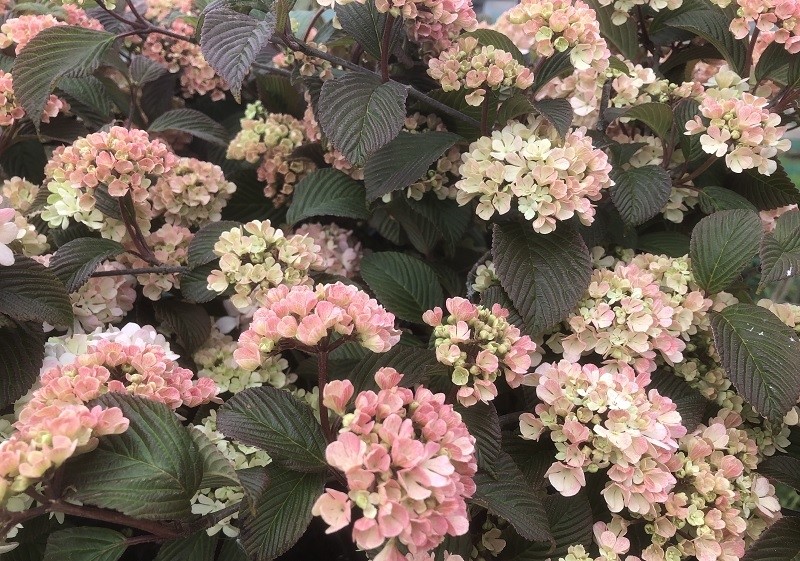
VIBERNUM MARY MILTON (AKA ‘SNOWBALL VIBERNUM’)
Price Range: $$$
Water Vase Life: Good
Foam Life: Not Great (Ok if kept cool and watered)
Out of Water: Not recommended
Qualities: Gorgeous ribbed foliage, warm color variation, adorable flower puffs
Uses: Coverage, texture, interest
Be still my beating heart!!! Show me a more adorable foliage… I’ll wait.
Can I just move to Oregon please? This is my third and final stop on the Vibernum train (in no particular order of favorites, of course) before I get too carried away. This one obviously has a distinctive look, but with today’s brides loving all those femme mauve and blush tones, I always seem to find an opportunity to incorporate this foliage into at least one of my Summer weddings. She needs a long, angled cut for maximum hydration as she is a thirsty gal, but totally worth all the headache if you ask me.
AUTUMN

MAGNOLIA FOLIAGE
Price Range: $$
Water Vase Life: Excellent
Foam Life: Excellent
Out of Water: 1-2 days before drying out
Qualities: Large, shiny dark green leaves with brown velvet texture on the backside
Uses: Coverage & introducing warm color
Image Source: Florabundance Wholesale Flowers
Magnolia is another one of those foliages that is available *almost* year round and can give you that warm color tone and earthy feel with maximum impact and great coverage. But since there are a few months that it’s tricky to get your hands on, i’m sticking it under the Autumn section. The season starts in September and it usually sticks around until February. It comes in a variety of heights but most often you will see it in short, 5-stem bunches (about 40-50 cm) classified as Magnolia ‘tips.’ (If you don’t see it on the sales floor, check in those cold packed boxes of bulk greenery towards the back of the cooler!) When in season, you can sometimes score extra tall branches of Magnolia which is amazing for creating structure and mass for those large scale installations. Magnolia is usually safe to count on because it’s not suuuuper seasonal or tricky to source. Just be sure to pre-order in advance if it’s a must-have!
I love using Magnolia for an earthy twist on a glam look, paired with bold white blooms like Peonies, Dahlias, Roses, or Orchids.
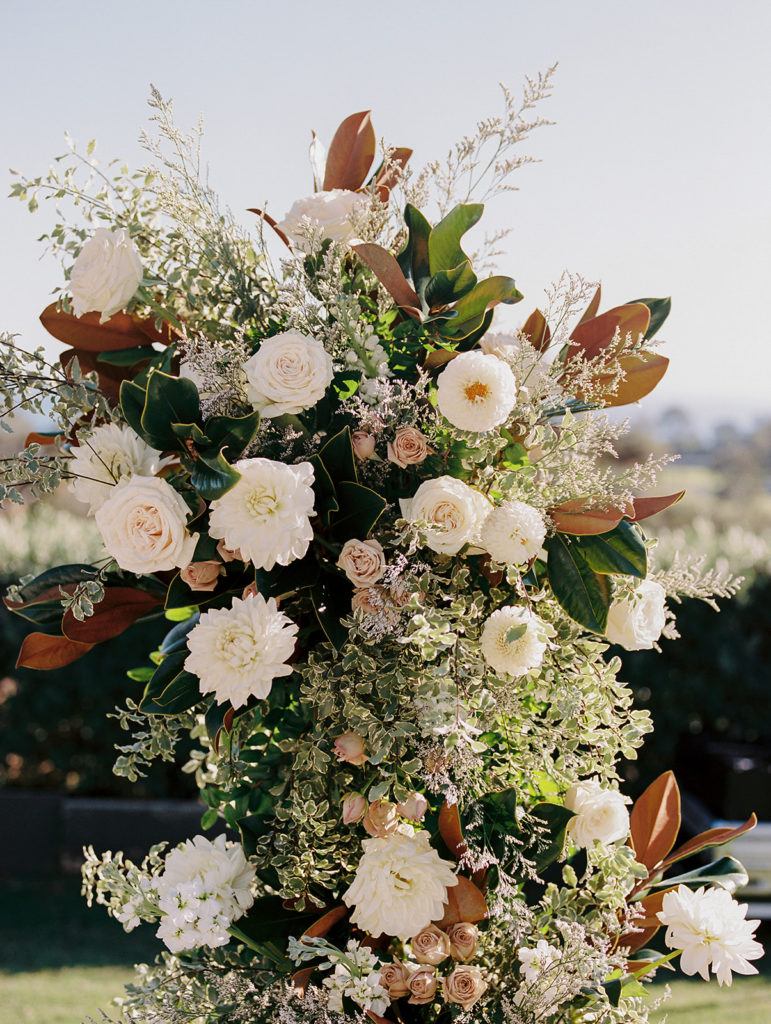
Image by Natalie Bray
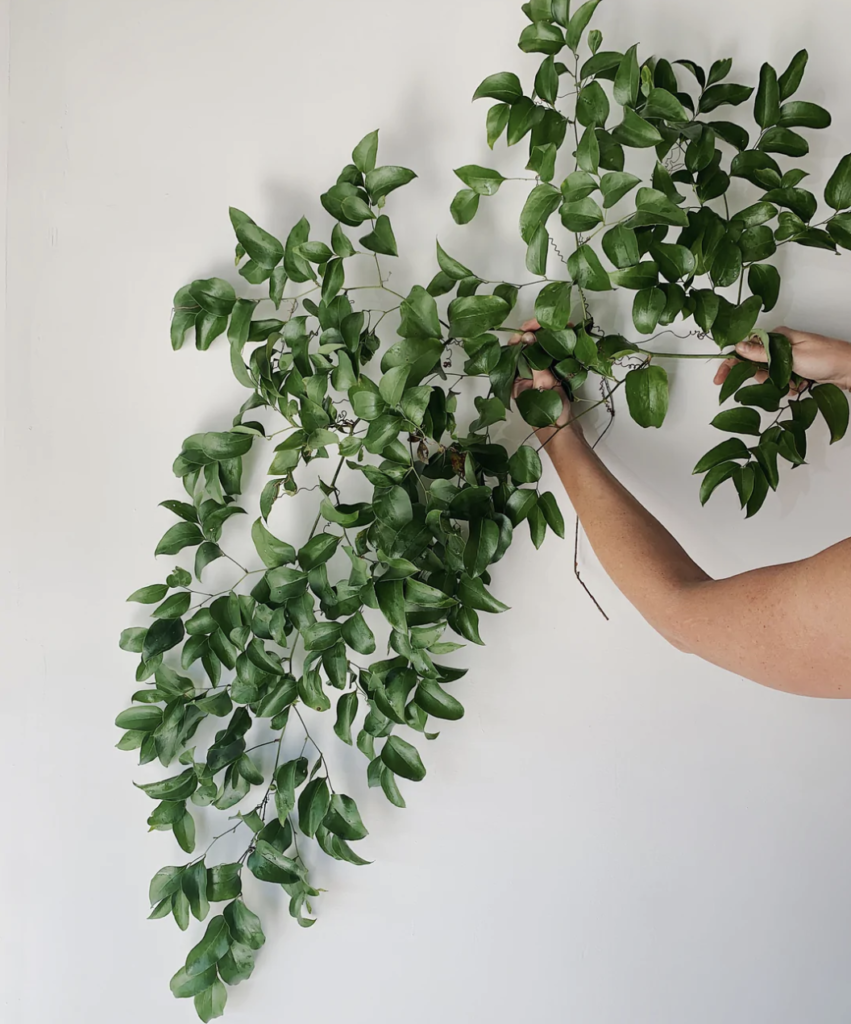
SOUTHERN SMILAX
Price Range: $$$$
Water Vase Life: Excellent
Foam Life: Excellent
Out of Water: Fine for multiple days
Qualities: Huge vines (up to 10-ft) with luxe, shiny green leaves
Uses: Large installations, pergolas, overhead installations
Image Source: Root Floral
Southern Smilax (‘Southern’ being an important keyword when ordering – not to be confused with the more traditional wedding Smilax) is every florist’s dream for large scale installations because of it’s ability for easy coverage of huge areas with it’s utterly MASSIVE vines. It comes at a premium though – anywhere frop $150-$300 wholesale per box (a box usually containing 10 large stems) depending on the source. (My favorite source is East Texas Smilax)
I think the image above speaks for itself on how amazing this foliage is for coverage while still providing that airy look. Pretty much anytime you see an image of an airy, overhead canopy of greens or a large pergola draped in delicate vines, Smilax is most likely what’s been used. There really is no solid substitute for this incredible vine sourced from the South (hence the name) mainly Texas. I’m categorizing it under Autumn because the season begins in August, but it is usually abundant all the way through April. It gaps in Summer, and the floral industry weeps….
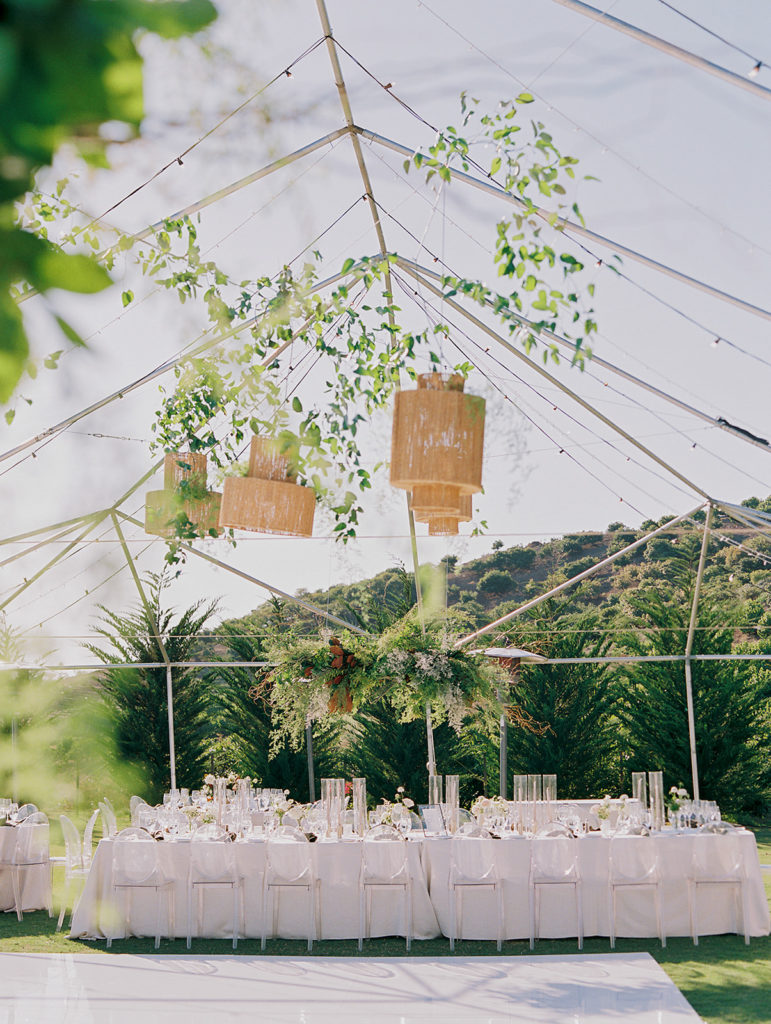
Image by Natalie Bray
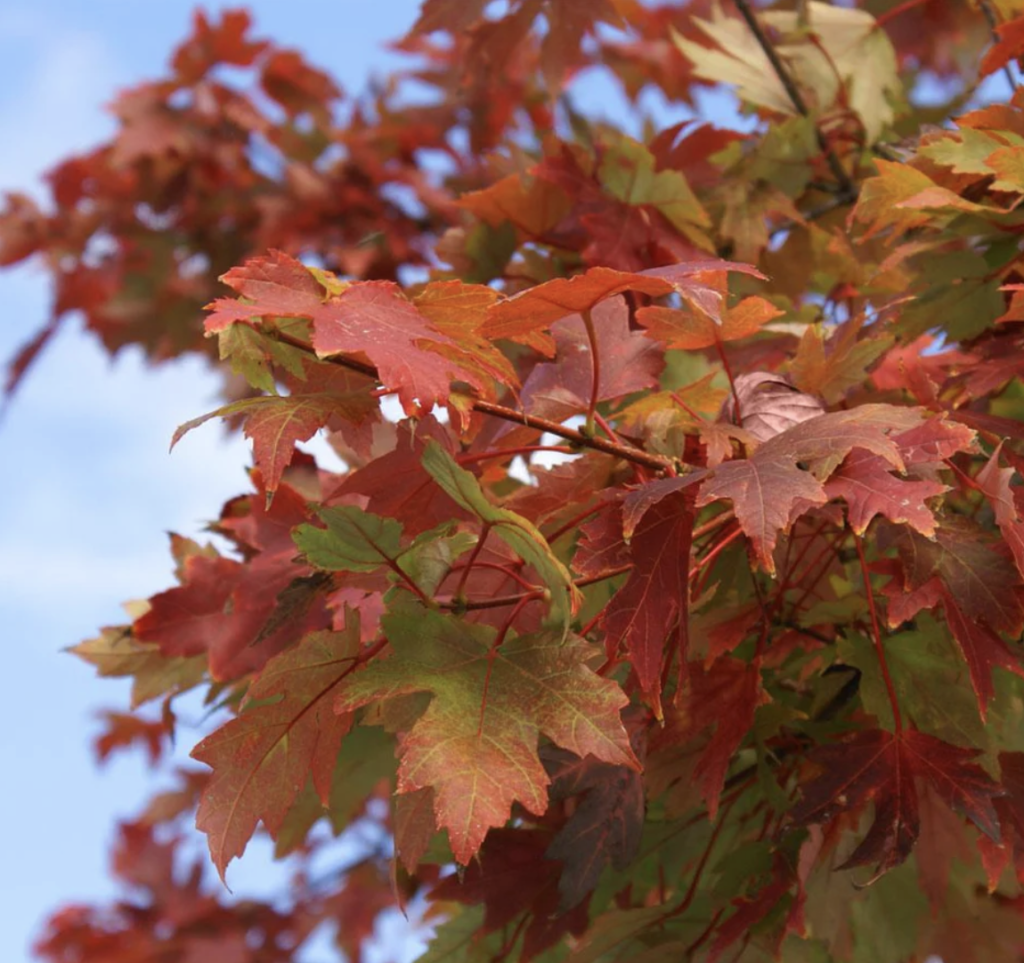
Autumn Maple
Price Range: $$
Water Vase Life: Good
Foam Life: Good (might see some drying of leaves)
Out of Water: 1 day before drying
Qualities: Large, showy branches, fall color
Maple actually starts in Summer in bright green and then transitions into its fall colors around September – but let’s be real, we really just want it for the colors! There are obvs plenty of pretty fall color options out there come Autumn, but I’d say Maple is the shining star.
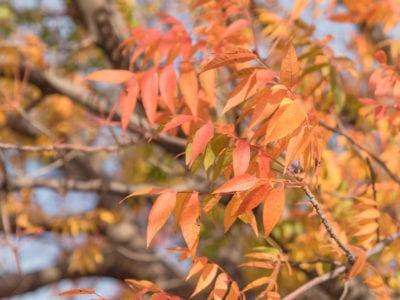
Pistachio Foliage
Price Range: $$
Water Vase Life: Good
Foam Life: Good (might see some drying of leaves)
Out of Water: 1 day before drying
Qualities: Large, showy branches, fall color
Pistachio is another beautiful Autumn showstopper, and I’d say it’s colors lean more towards golden yellow, pinks and coral than your typical orange and red. The colors are absolutely insane, and what I believe is really distinctive about this foliage (aside from it’s narrow leaves that have a lovely relaxed look). Because of the lovely unique shape of the leaves, they also cast stunning shadows when the light hits it just right.
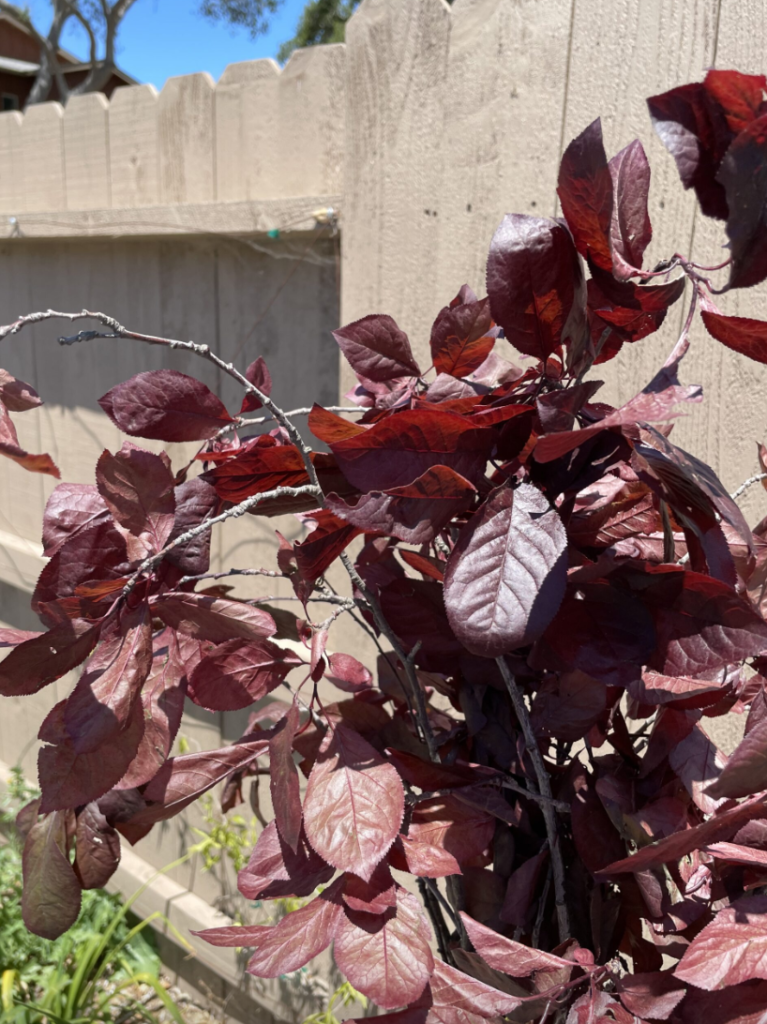
Plum Foliage
Price Range: $$$
Water Vase Life: Good
Foam Life: Good
Out of Water: Not recommended
Qualities: Tall, linear branches, deep plum colored leaves
For those clients who aren’t into the traditional red/orange Fall vibe, plum is a great option. These make the most sense as a fall texture, but they are also available in Spring. The color works well as a backdrop for a blush-to-burgundy palette, or just some unexpected drama for any bride who’s down for a moodier look. The foliage is delicate and does need to be kept well hydrated, but it comes on tall, woody stems (almost an inch thick) and you can snip quite a bit from a single bunch to use in smaller bits, or use the full stem for more dramatic impact. For as long as burgundy has been a thing for weddings, this has been a go-to for me.

Image by Michelle Flores
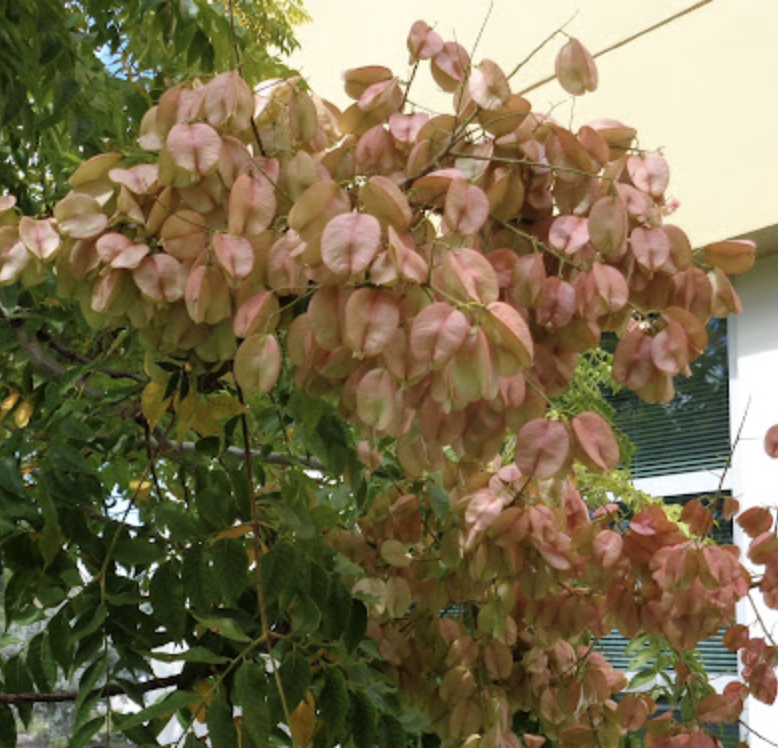
Rain Tree Pods
Price Range: $$
Water Vase Life: Good
Foam Life: Good
Out of Water: Ok – Look nice fresh or dried!
Qualities: Pods ranging from Golden to Coral
(Side note: Google ‘Rain Pods’ for a laugh!)
They’re quite unique, aren’t they? I mean, it’s not a typical “wedding” type flower, nowhere near a fluffy pink peony, but I swear… every time I use these, everyone wants to know, ‘What are those cool pod things?!” These are one of those showstoppers. You can’t not notice them. But also, if the colors blend in just right, and it just makes sense, they can give a piece this incredible harmony and add so much fun texture at the same time.
I’m all about using those unique and distinctive textures in my work, because that’s what makes a piece special. Ya know? So I say when you have those trusting brides, go for it!
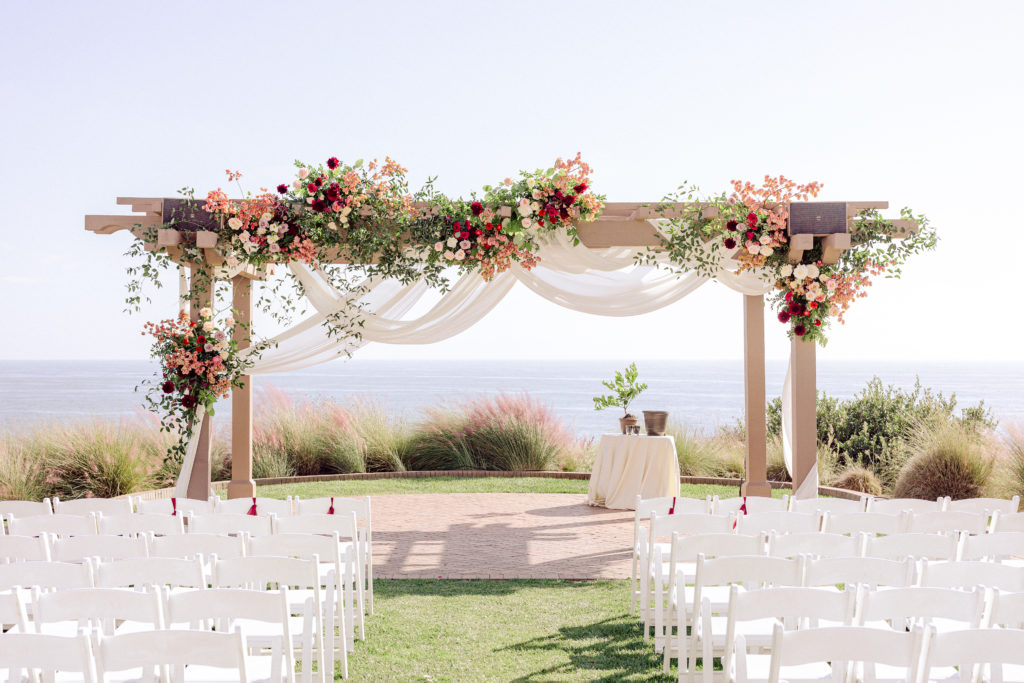
Image by Chard Photography
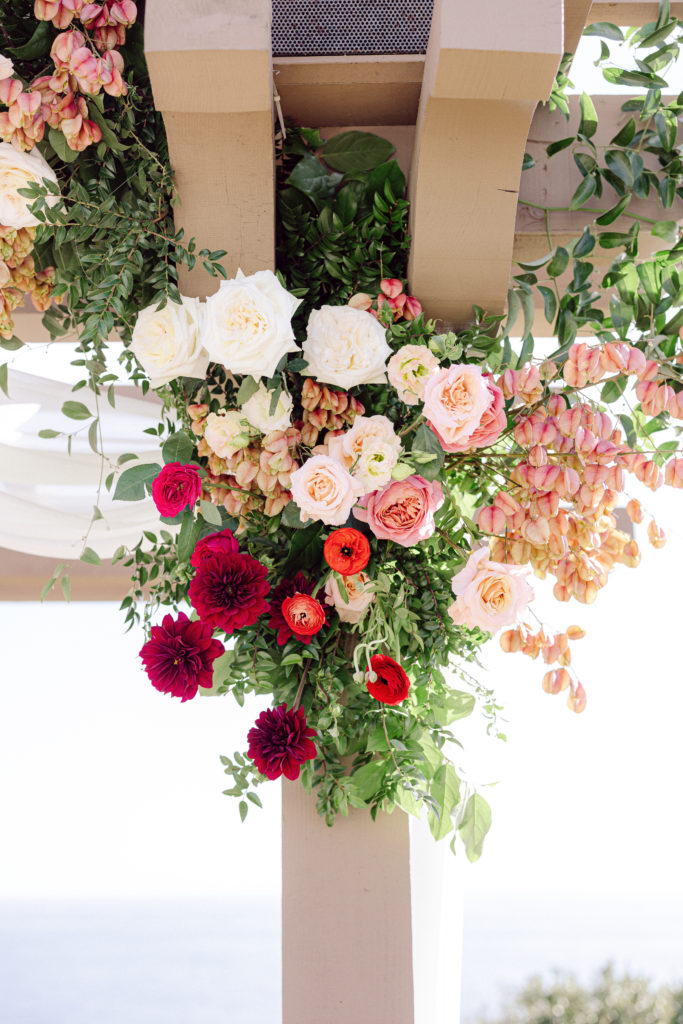
More Great Resources
Looking for more help with floral recipes? Check out my Floral Recipe E-books!
Learn my complete design process, including a lesson in floral installations in my digital course, Artfully Arranged!

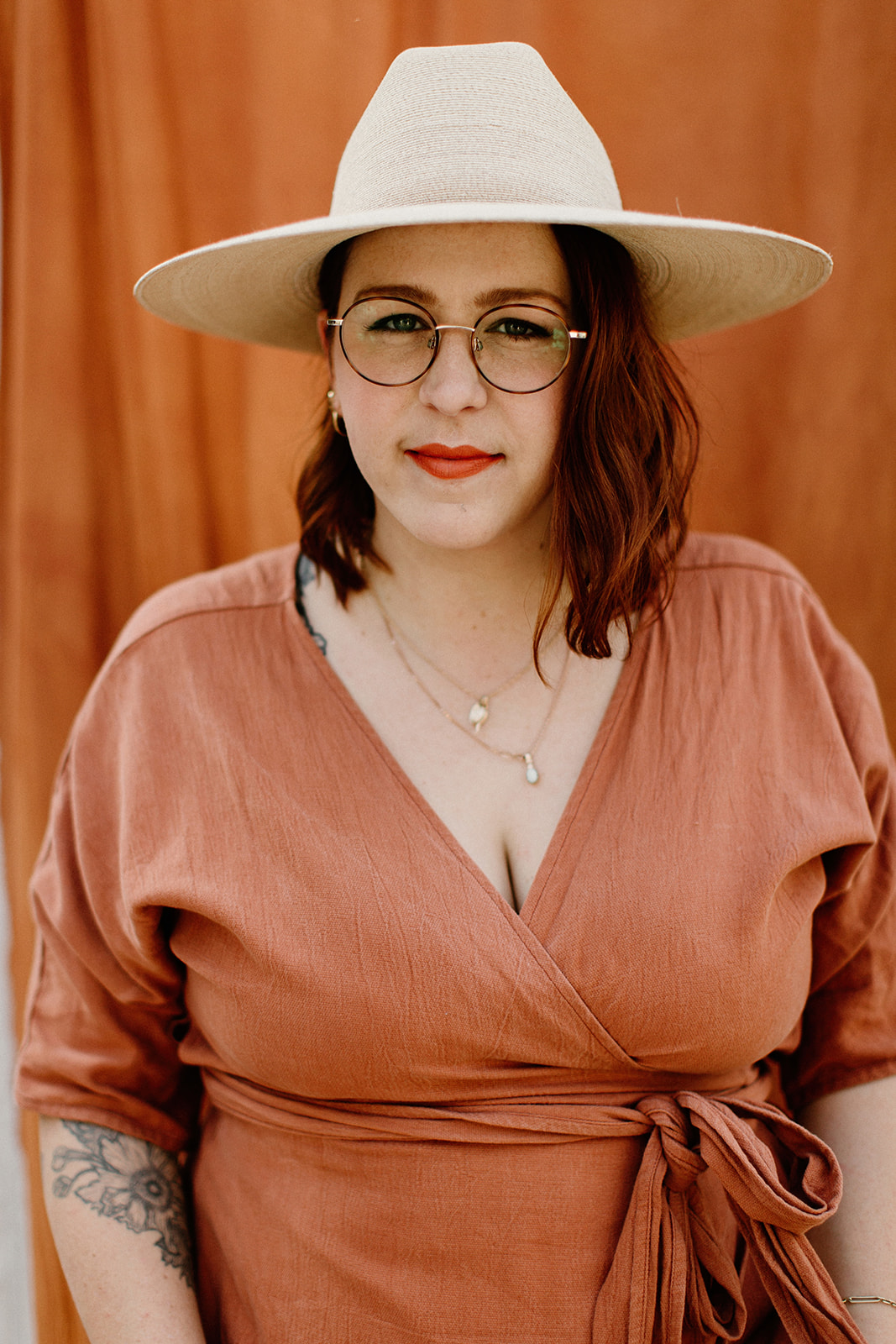
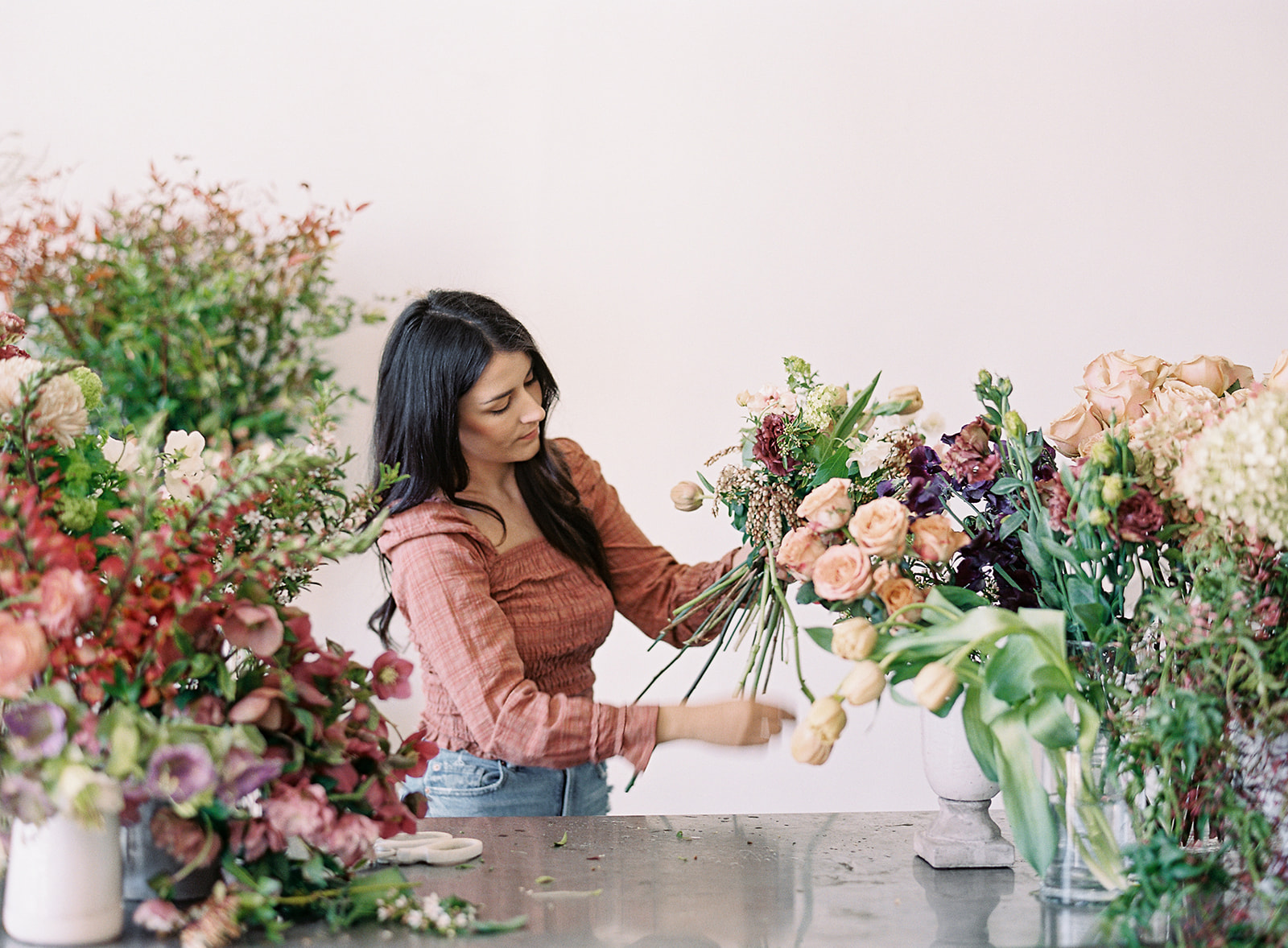

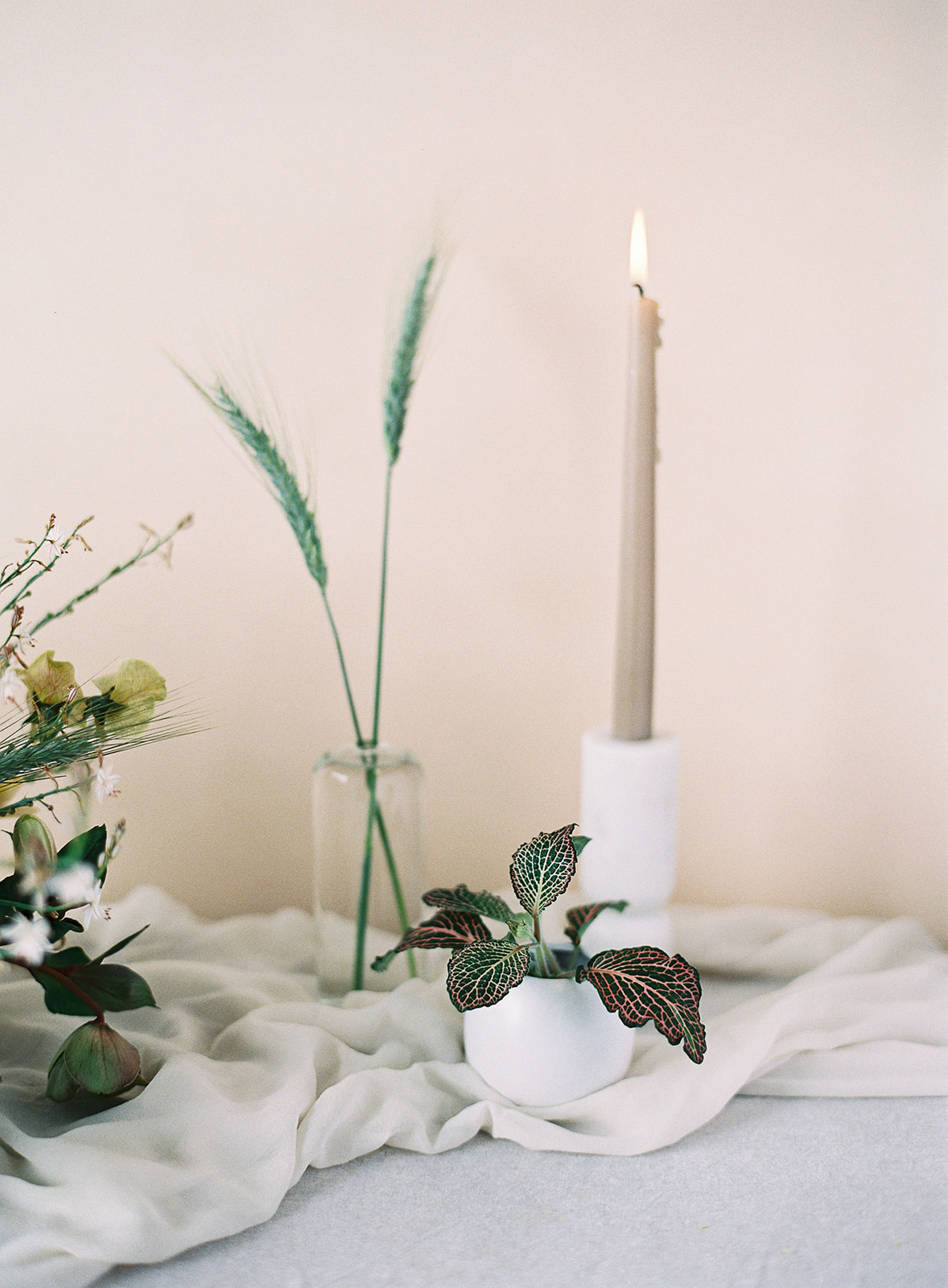

add a comment
+ COMMENTS